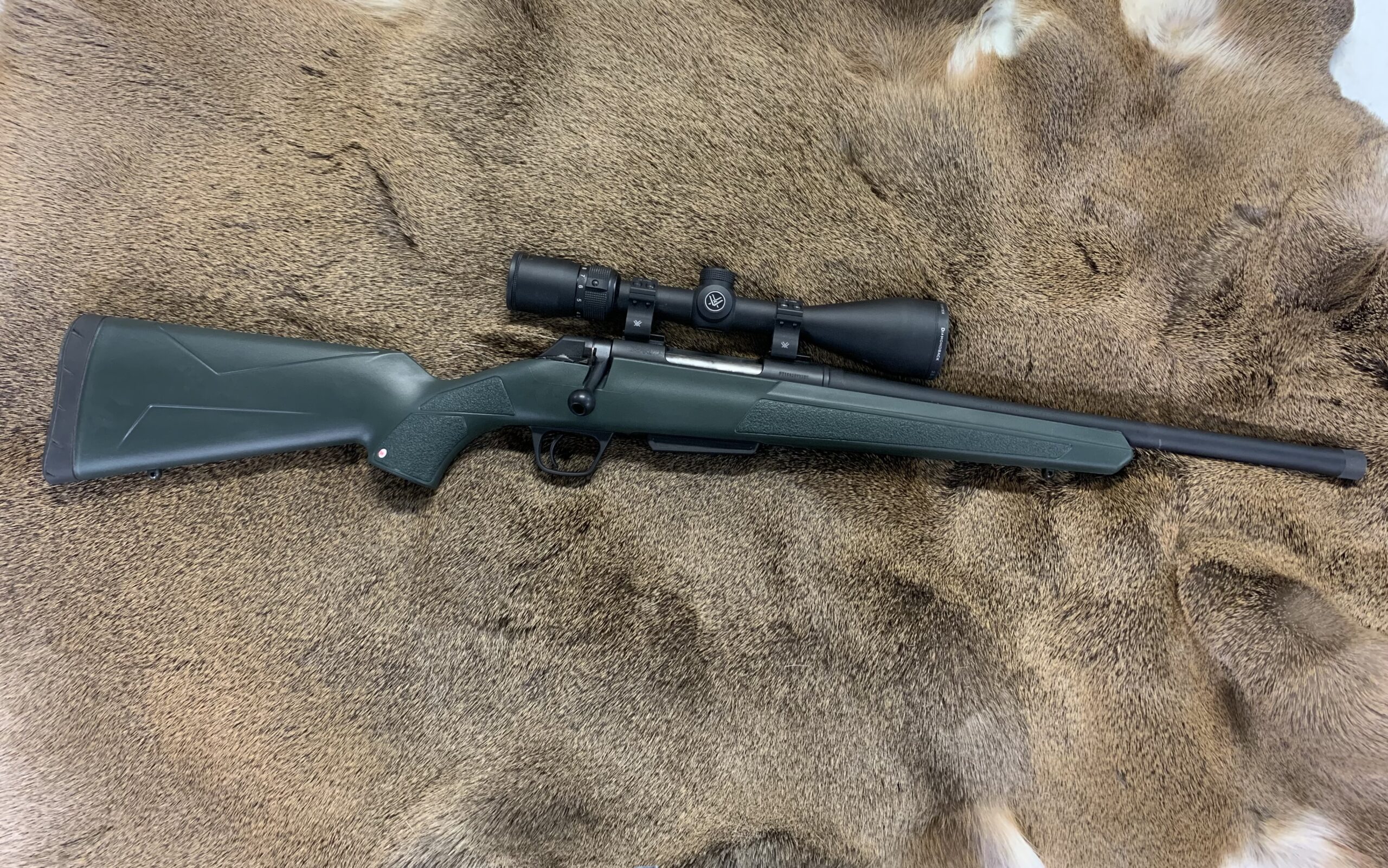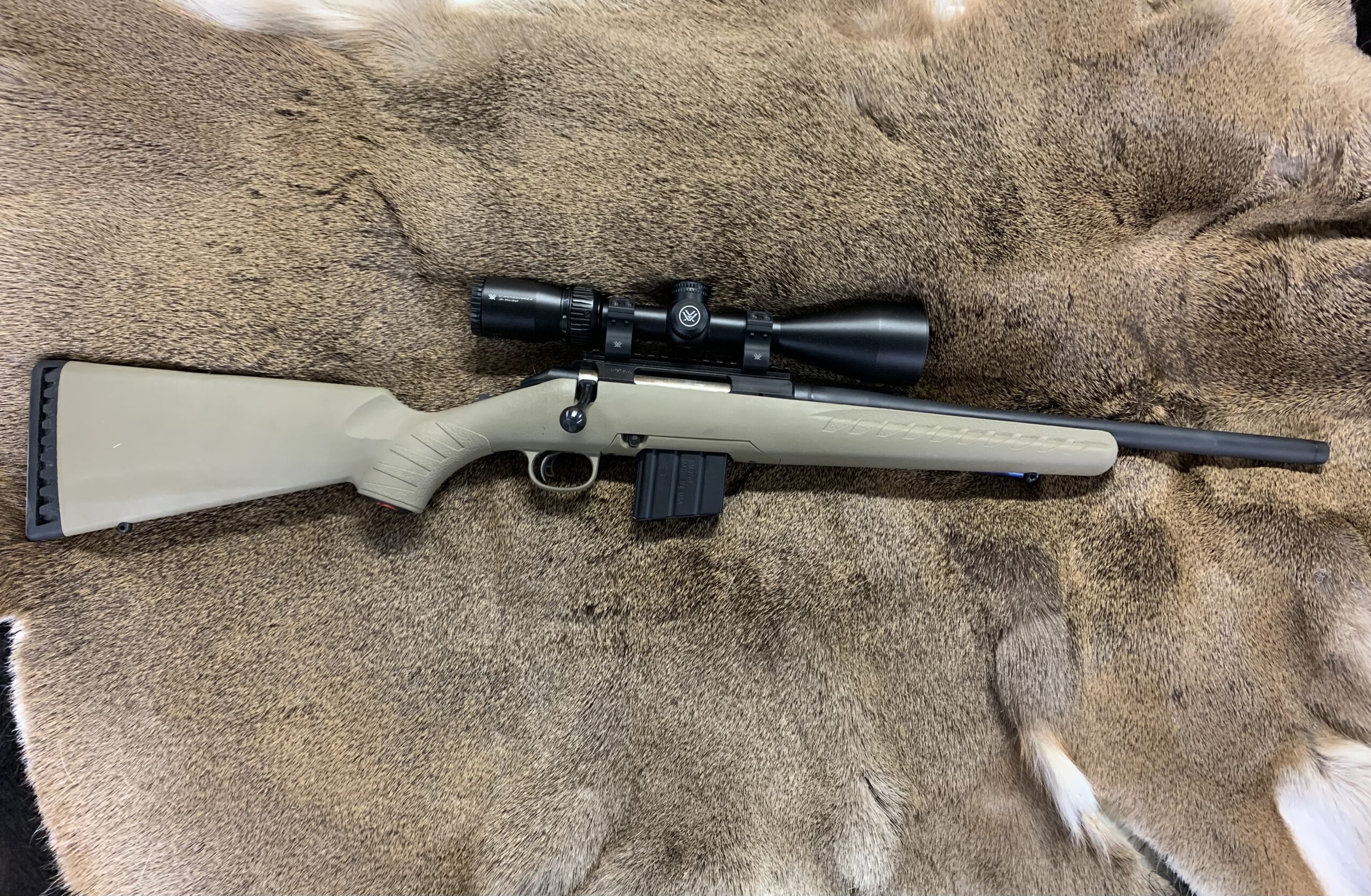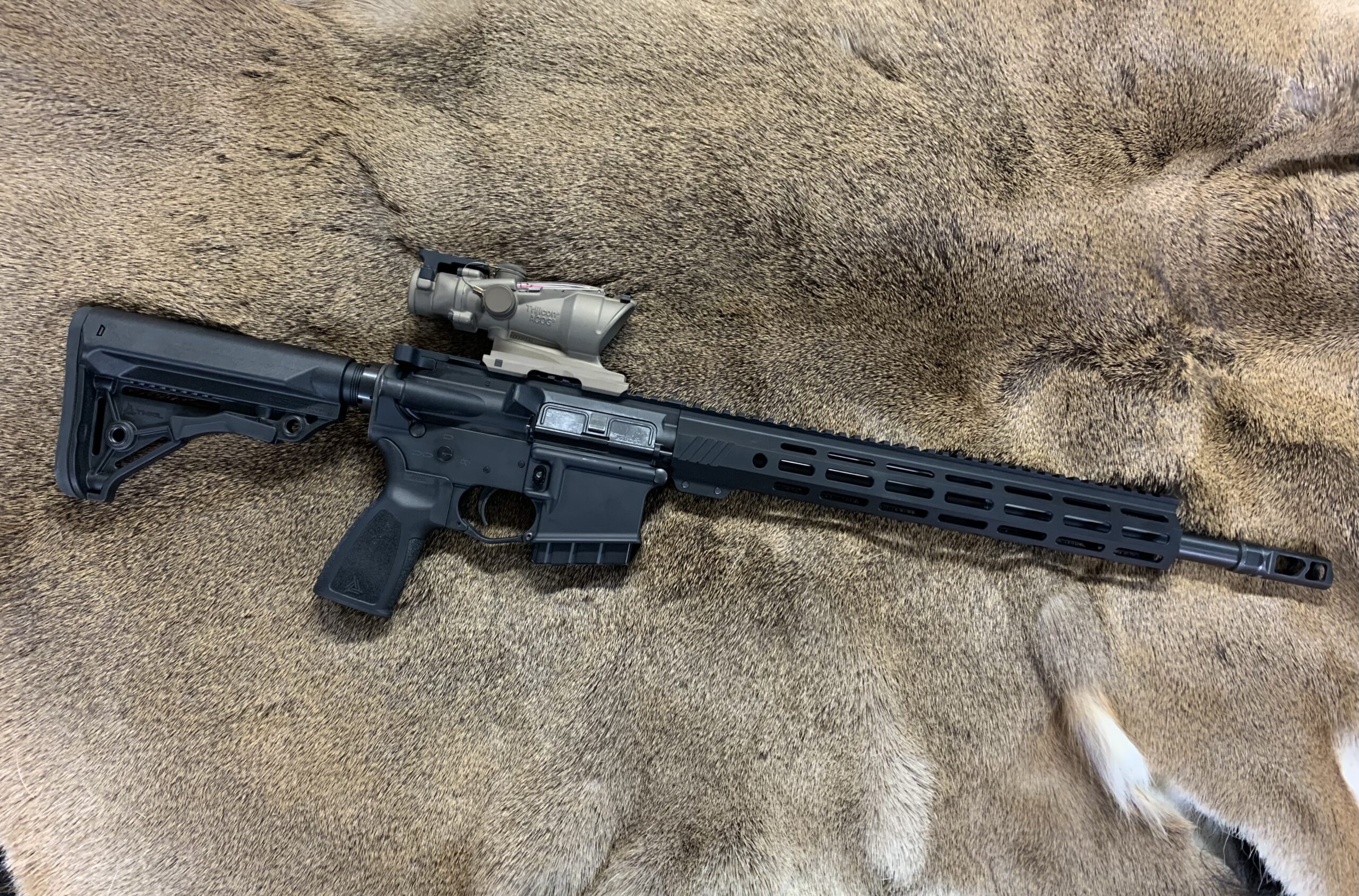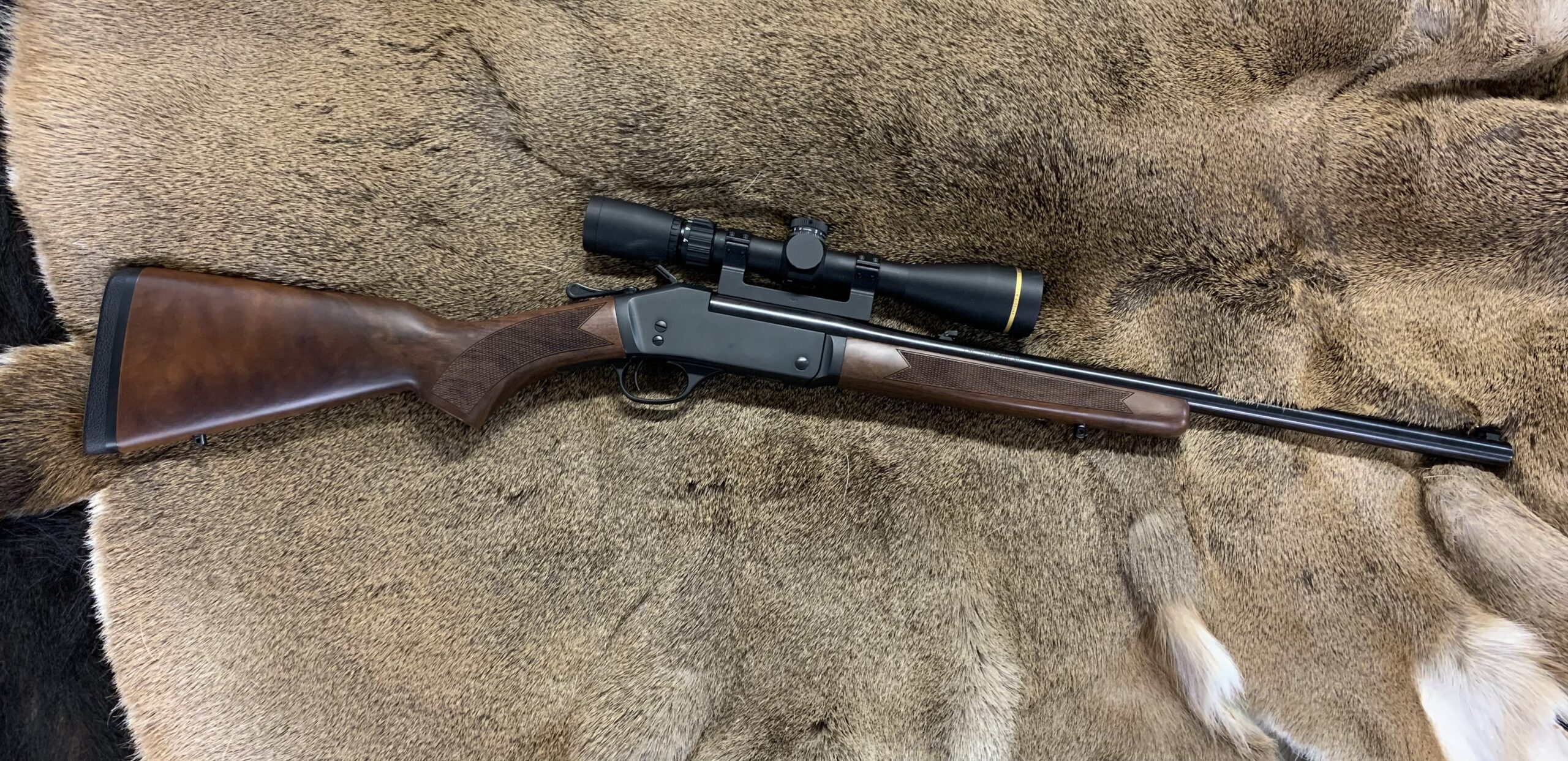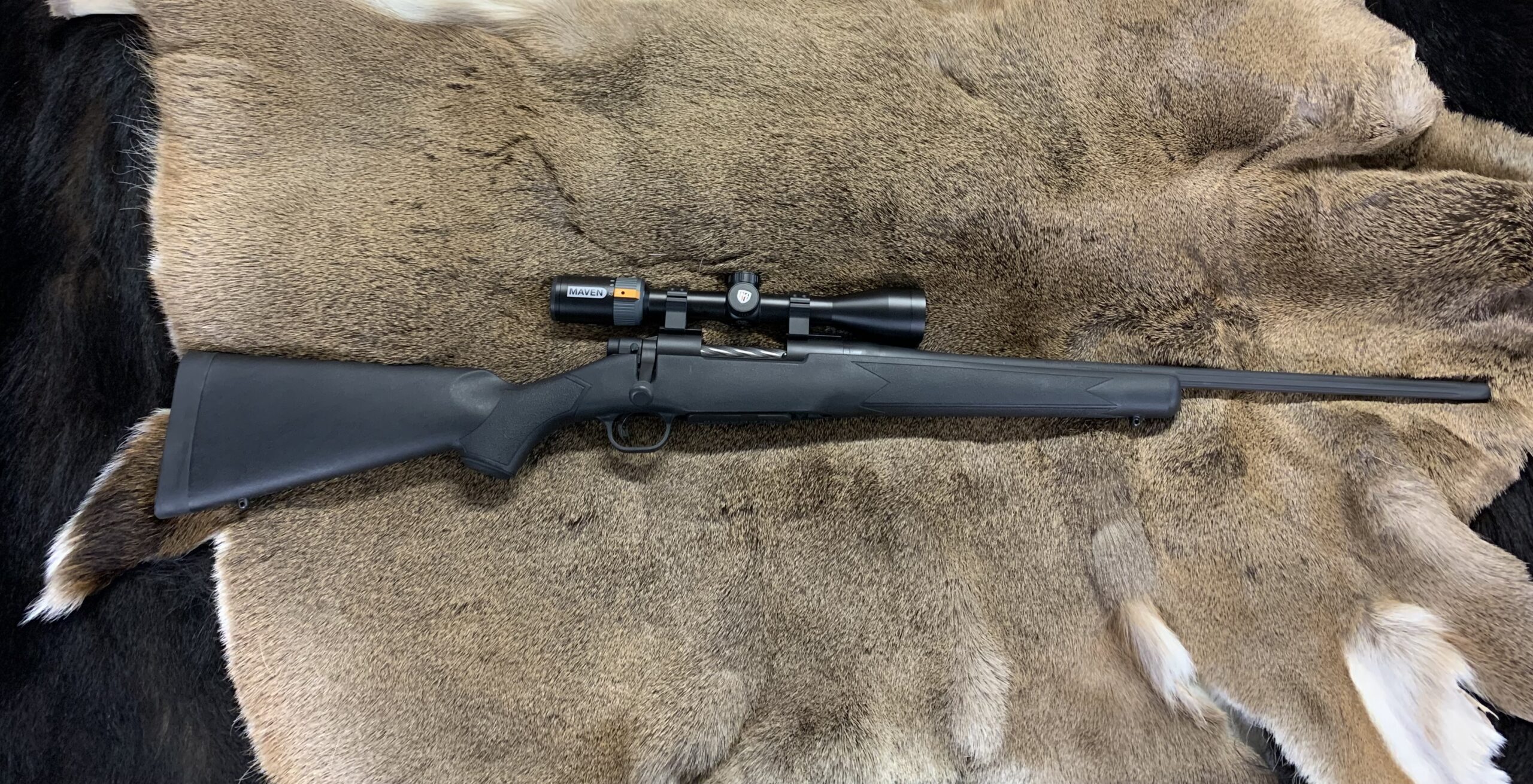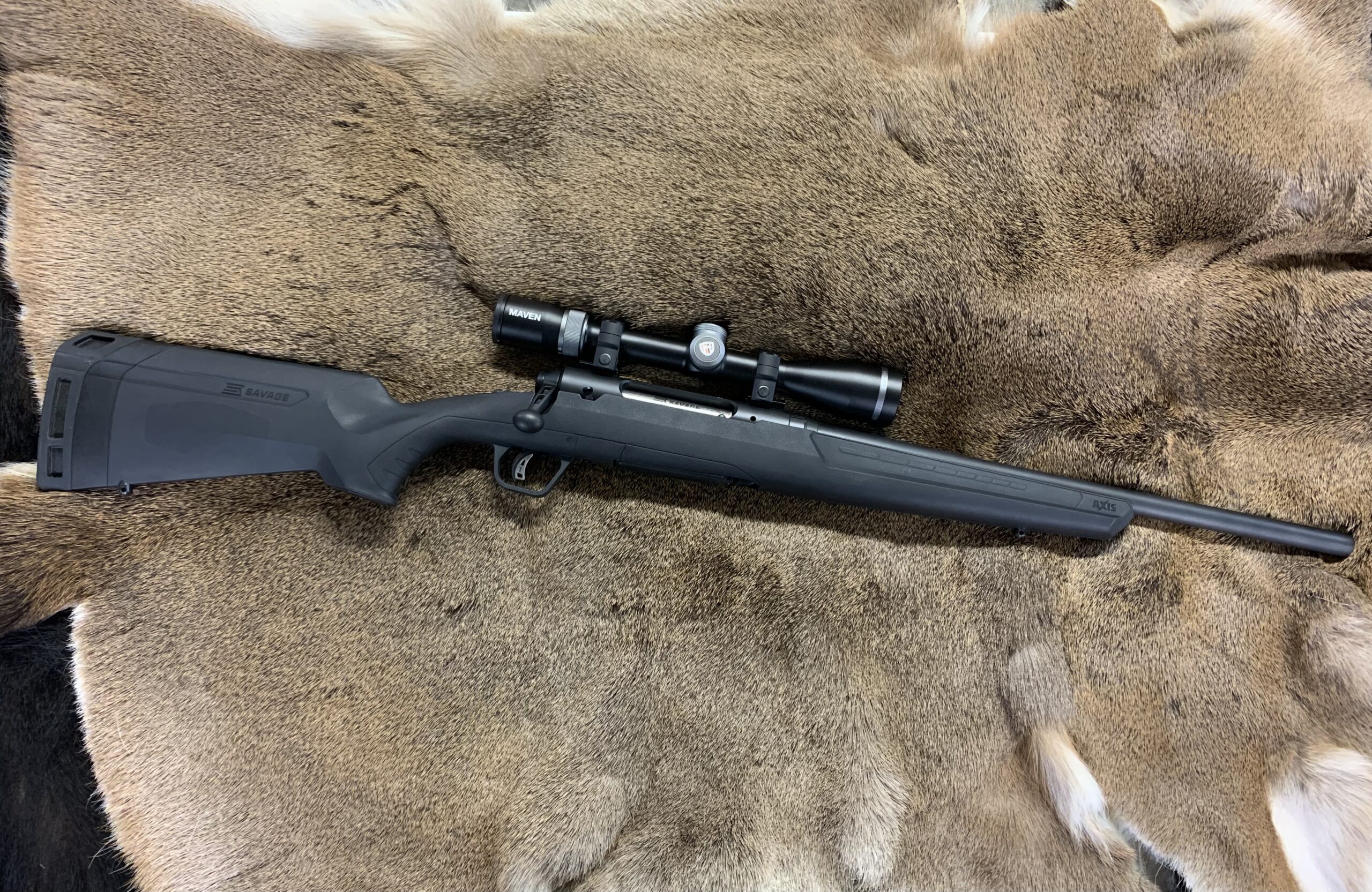We may earn revenue from the products available on this page and participate in affiliate programs. Learn More ›
Updated Oct 5, 2023 6:02 PM
The .350 Legend is a cartridge that’s designed for whitetail hunters—specifically those in states that only allow the use of straight-wall rifle cartridges in a deer rifle. It was released in 2019 by Winchester, and although singularly purposed, it’s been well-received. The .350 Legend has found popularity even in states like Kentucky that don’t require straight-wall cartridges—something I found out on a recent trip to the Bluegrass State. Because of the Legend’s increasing popularity, we felt it was our duty to put some of the best .350 Legend rifles through extensive testing, so you know exactly what you’re getting.
Purpose and Design of the .350 Legend
To those in western states, the prospect of a cartridge like the .350 Legend might seem like a solution without a problem—but that’s not the case back east. In states that require straight-wall cartridges for deer hunting rifles, the .350 Legend fills a niche between larger options like the .45/70, .444, and .450 Bushmaster, and smaller revolver/lever-gun cartridges. Winchester’s selling points on the Legend are that it’s the “fastest straight-walled cartridge on the market,” with more energy than a .30/30 or .300 blackout, but less recoil than a .243 Win. It’s admittedly a sub-200-yard gun, but that’s just fine for most eastern whitetail hunters.
It’s easy to make assumptions about the roots of the .350 Legend, and many think that it’s simply a straight .223 Rem. case. The Legend doesn’t have a parent case but is more along the lines of an extended 9mm Luger with a smaller rim. The case rim is the same diameter as the .223 Rem/5.56 cartridge, which allows the use of the same bolt face—something that makes it ideal for the AR platform. The body of the case, however, is about .013 inches larger than the .223. This still allows the cartridge to be used in AR magazines, but with a specific .350 Legend follower.
The Legend shoots a .355-inch-diameter bullet, with common hunting loads in the 150- to 180-grain range, between 2200 and 2400 feet per second. It’s not a flat shooter, but most loads zeroed 2 inches high at 100 yards would be about 2.5 inches low at 200 yards.
Testing .350 Legend Rifles
Sometimes cartridges that aren’t expected to perform at distances beyond 200 yards aren’t taken (or tested) as seriously as the latest and greatest X-cutter, but we didn’t give the .350 Legend any slack. I tested six different rifles according to the same protocol we use at our annual rifle test. I evaluated the ergonomics, handling, workmanship, and accuracy of these rifles and spent some serious time shooting them.
For my accuracy data, I fired a minimum of 20 five-shot groups through each rifle at 100 yards, testing eight different factory loads. I tried each type of ammo in each rifle but focused my shooting with loads that the individual rifle seemed to prefer. This gave each rifle the chance to show its potential. The published group sizes for each rifle include the average of the top 10 groups fired (which is a good representation of the rifle’s potential), and the overall average group size (which gives you an idea of how the rifle shoots a broad range of factory ammunition).
Best .350 Legend Rifles: Reviews and Recommendations
Key Features
- Cartridge: .350 Legend
- Capacity: 4+1 rounds, detachable box magazine
- Action: Bolt action, three-lug
- Stock: Injection-molded composite, green
- Weight: 6 pounds, 8 ounces
- Trigger: 3 pounds, 0 ounces (measured)
- Barrel: 16.5 inches, threaded muzzle (11/16-inch x 24), with thread protector
- Overall Length: 36.5 inches
- Price: $730
- Optic Used: Vortex Diamondback 3.5-10×50
- Average Overall Group Size: 1.74 inches
- Average Size of Top 10 Groups: 1.04 inches
Pros
- Smooth Action
- Great Production Trigger
- Very Accurate
- Short, Suppressor-Ready Barrel
Cons
- Only 4-round Magazine Capacity
The Winchester XPR is an affordable deer rifle that’s both accurate and dependable. I tested one chambered in .308 in a recent roundup of budget rifles, and was eager to see how it would perform in .350 Legend. The XPR has a push-feed, three-lug action with a short 60-degree bolt throw. It’s fed from a single-stack detachable magazine, and both the barrel and action have a Perma-Cote finish.
The XPR’s stock is stiff and durable, but the butt is a little noisy and hollow sounding when brushed against branches and sticks. The stock is somewhat blocky but comfortable to handle, and it has a nice rubber recoil pad.
This specific XPR model, the XPR Stealth SR, features a 16.5-inch, .755-inch-diameter barrel that’s tapered up at the muzzle to .840 inches and threaded for a suppressor. The short barrel makes the rifle handy in tight quarters, and not excessively long with a suppressor mounted. Although most 9mm pistol barrels are threaded in ½-inch x 28, this rifle’s muzzle threads are 11/16-inch x 24. It also includes a Picatinny rail for mounting optics.
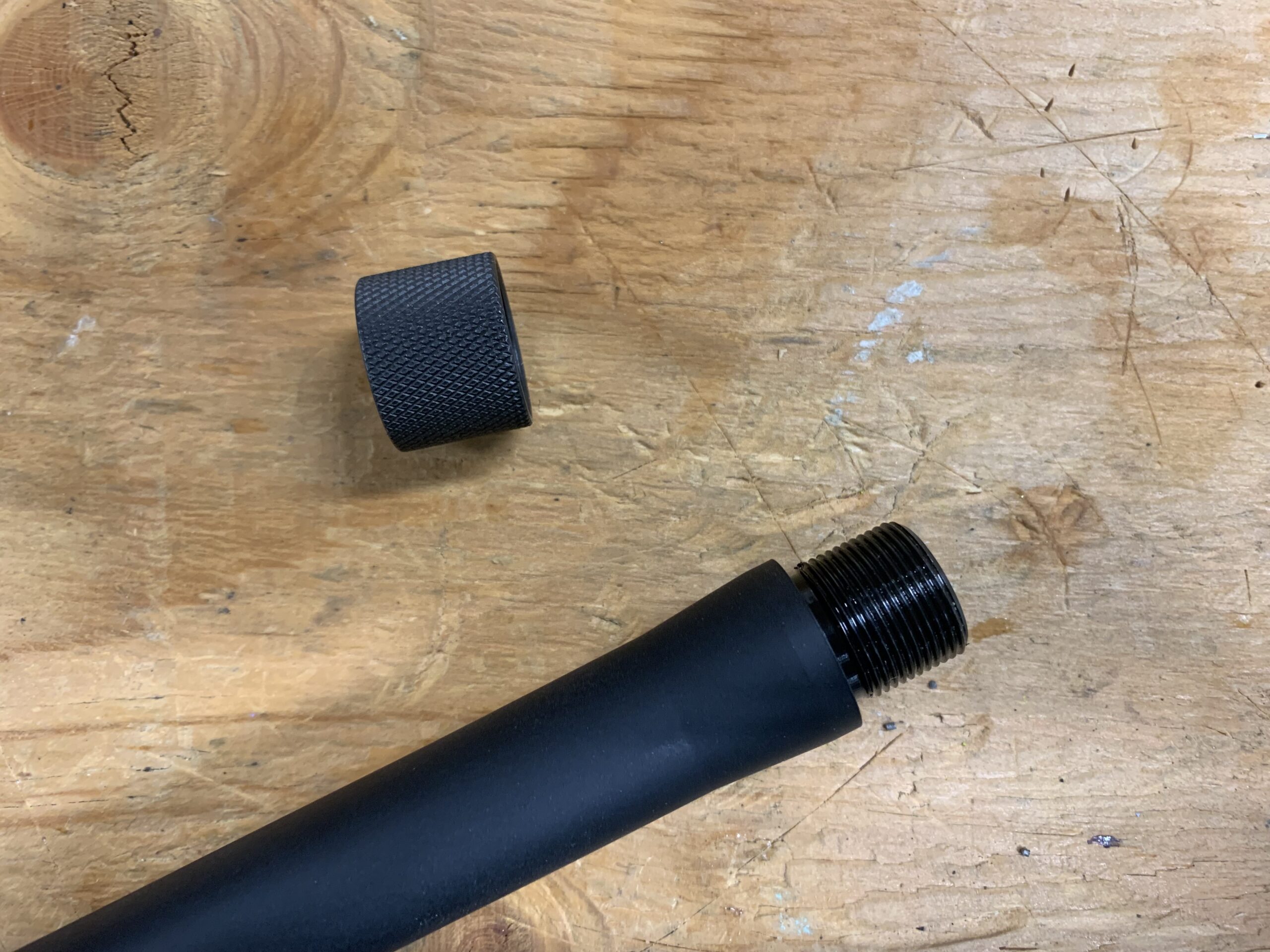
Shooting the Winchester XPR
The short-throwing, smooth action caters well to the little .350 Legend cartridge. I could cycle the rifle quickly while staying right on target and ejection of cases was robust and reliable. The rifle is also an easy one to single feed. The magazine design is such that single rounds can be dropped into the receiver and will glide smoothly into the chamber.
At three pounds, the trigger weight was good, and the XPR’s trigger has almost no take-up or overtravel. The safety of the XPR is located just right of the bolt shroud and locks the bolt when engaged. There is also a small bolt-override button that allows you to open the bolt while the rifle is on “safe.”
This .350 Legend rifle was shockingly accurate. Even with that stubby little cartridge, the XPR reliably printed five-shot groups that more than a few mid-priced hunting rifles would be jealous of. The most accurate ammo was Winchester’s Super X 180-grain Power Point. It averaged under 1.4 inches with four different types of ammo, but several loads produced some sub-MOA 5-shot groups.
Key Features
- Cartridge: .350 Legend
- Capacity: 5+1 rounds, detachable AR magazine
- Action: Bolt action, three-lug
- Stock: Injection-molded composite, flat dark earth
- Weight: 6 pounds, 2 ounces
- Trigger: 4 pounds, 6 ounces (measured)
- Barrel: 16.38 inches, threaded muzzle (.5-inch x 28), with thread protector
- Overall Length: 36.5 inches
- Price: $520
- Optic Used: Vortex Crossfire II 3-9 x 50 Straight Wall BDC
- Average Overall Group Size: 1.50 inches
- Average Size of Top 10 Groups: 1.12 inches
Pros
- Good Ergonomics
- Uses AR Magazines
- Very Accurate
- Short, Suppressor-Ready Barrel
Cons
- Action is rough
- Trigger is a little rough and noisy
The Ruger American is one of the most popular budget-friendly rifles on the market today, and they have a reputation for great accuracy. The Ranch Rifle variant of the American in .350 Legend is a slightly modified variant that’s purpose is right in the name. It’s designed to be an all-around rifle for the truck, UTV, or the hunting blind.
The Ranch Rifle is built on the same push-feed, three-lug action that the other American variants are. The action nests into two V-shaped blocks in the stock which act as both bedding pillars and recoil lugs. It features an FDE-colored injection-molded stock and includes a Picatinny optics rail.
Ruger American Ranch Rifle Magazines
Unlike other American models, the Ranch Rifle is fed by AR magazines via a unique polymer magwell that incorporates an AR magazine catch and button. Rather than a button or lever on the bottom of the stock, the magazine is released by the AR mag catch on the side of the stock, just forward of the trigger guard. It’s a simple and cost-saving solution that works, but the button is a little far forward and partially covered by the upper portion of the stock.
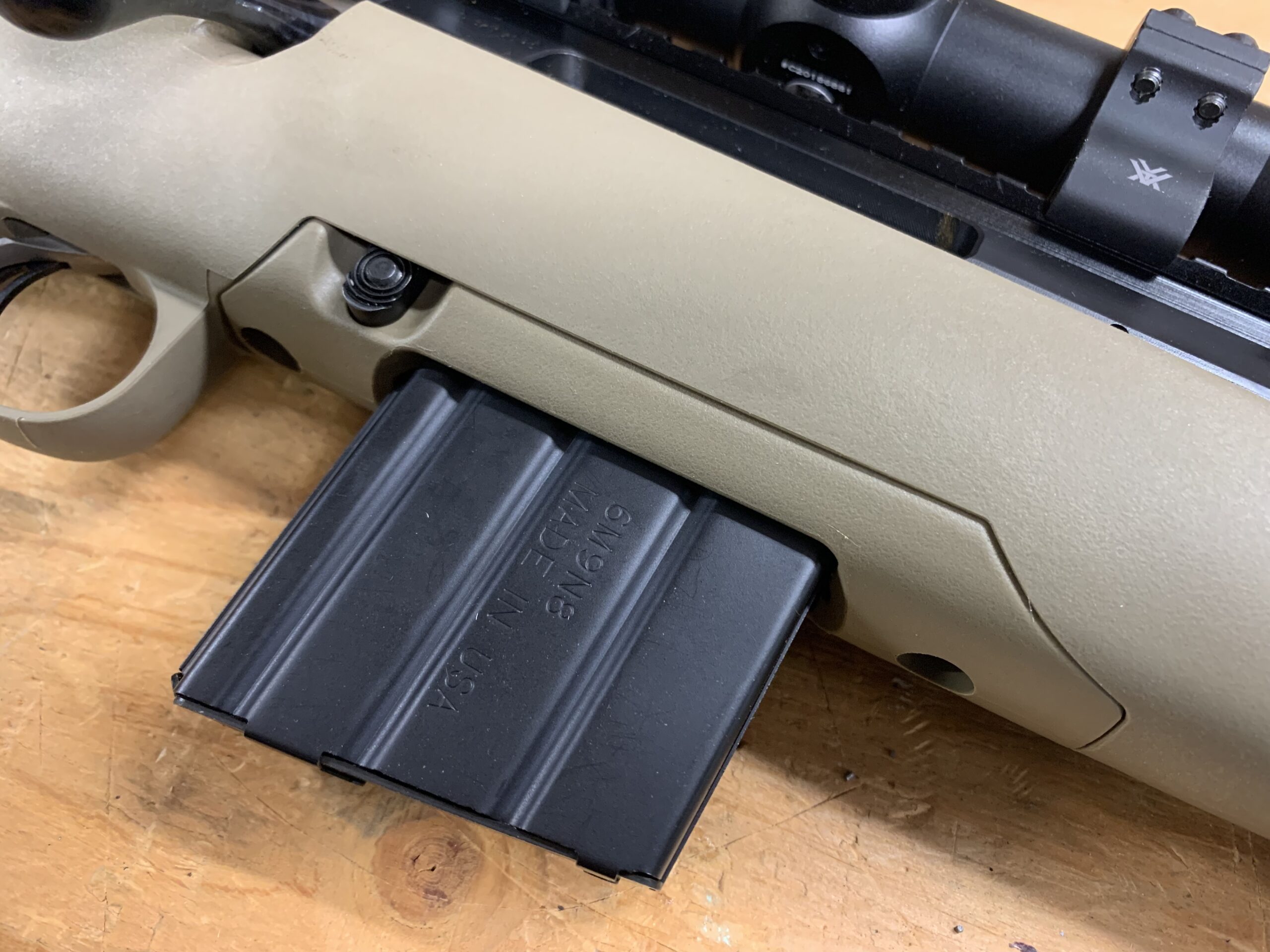
The barrel is just shy of 16.5 inches and threaded in ½-inch x 28 (typically a 9mm Luger threading). This makes it easier to use with a wide variety of suppressors, and despite the barrel being thin at the threads, it seems to work just fine with my Silencerco Hybrid 46.
When you’re buying low-cost rifles, there are always tradeoffs, and that’s important to understand when evaluating budget rifles. The American Ranch rifle does some things great, and others not so great. It’s your job to decide what you want to spend, and what compromises are OK with you.
Shooting the Ruger American Ranch
First, I’ll tell you the good, or even great news. This rifle shoots. The Ruger Americans shoot well in-general, but I was impressed by the accuracy of the .350 Legend in this rifle. An aggregate of the best five-shot groups printed nearly as tight as the Winchester XPR, and across all ammunition types, this was the most accurate rifle in the test.
The most accurate ammunition was Winchester Deer Season 150-grain Extreme Point, fired with a suppressor. It averaged 1.14-inch five-shot groups. The rifle also did well with Winchester 255-grain Super Suppressed subsonic ammo, averaging 1.33-inch groups.
Another positive is that although the mag release takes a little getting used to, the additional capacity potential is great. On top of being a good deer rifle, it would likely make an excellent hog gun. The .350 Legend doesn’t seem to heat up the barrel (or suppressor) nearly as quickly as cartridges like the .223 or .308.
The Ruger American Ranch Rifle Action is a Little Clunky
The not-so-good side of the Ruger American Ranch Rifle is in its handling. The first thing I noticed about the rifle was how rough the bolt is to cycle. Part of this is due to the bolt face pushing over the magazine follower when empty but closing and opening the bolt were very rough, even with the magazine loaded.
A couple of times, I had a hard time closing the bolt to chamber a round in cold temperatures. The bolt operation did smooth out a little over time, but it still makes the XPR feel like a slicked-up Model 70 in comparison. The center bar on the trigger is also gritty, loud, and trigger pull in-general is so-so. Fit and finish isn’t great, but it’s not bad for the price, especially considering these rifles are intended to be used hard, not admired.
Most Versatile: Bushmaster Bravo Zulu
Key Features
- Cartridge: .350 Legend
- Capacity: 5+1 rounds, AR magazine
- Action: Semi-Automatic, Direct Impingement
- Stock: THRIL adjustable stock and grip
- Weight: 6 pounds, 5 ounces
- Trigger: 2-stage, 3 pounds, 15 ounces (measured)
- Barrel: 16 inches, threaded muzzle (11/16-inch x 28), with side baffle brake
- Overall Length: Adjustable from 33.5 to 36.5 inches
- Price: $895
- Optics Used: Leupold Mark 5HD 3.6-18×44 (accuracy testing), Trijicon ACOG
- Average Overall Group Size: 1.75 inches
- Average Size of Top 10 Groups: 1.40 inches
Pros
- AR Carbine ergonomics and function
- Suppressor-ready
- Good Accuracy
- 14-inch float tube with full-length Picatinny rail
Cons
- Some issues with the trigger on my sample
In the spectrum of versatile cartridges, the .350 Legend isn’t at the top. However, being perfectly sized to fit and function in standard AR rifles helps increase the .350 Legend’s usefulness for those who already want to hunt deer with it. The Bushmaster Bravo Zulu capitalizes on that potential, and is a no-frills, affordably priced AR that can fill several roles.
The Bravo Zulu is a standard-looking AR carbine with a 16-inch barrel and adjustable buttstock. The furniture on my sample is THRIL, but future production models are switching to Magpul Furniture. This is a direct gas impingement AR, meaning that gas is directed back into the action to cycle the bolt. The barrel is threaded in 11/16-inch x 24 and comes with a 2-chamber side-baffle brake.
The Bravo Zulu has a 14-inch octagonal free-float tube with a full-length Picatinny rail on top and M-LOK slots on the other 7 sides. The lower receiver features a tension screw to eliminate slop between the upper and lower, and this rifle comes with Bushmaster’s DM2S 2-stage trigger. It ships with a 5-round Bushmaster magazine and is compatible with other AR .350 Legend magazines. Although it appears that any standard 5.56mm/.223 AR magazine should work, the followers don’t allow the .350 Legend rounds to stack properly. Some aftermarket followers are available, but some magazines might not be completely compatible.
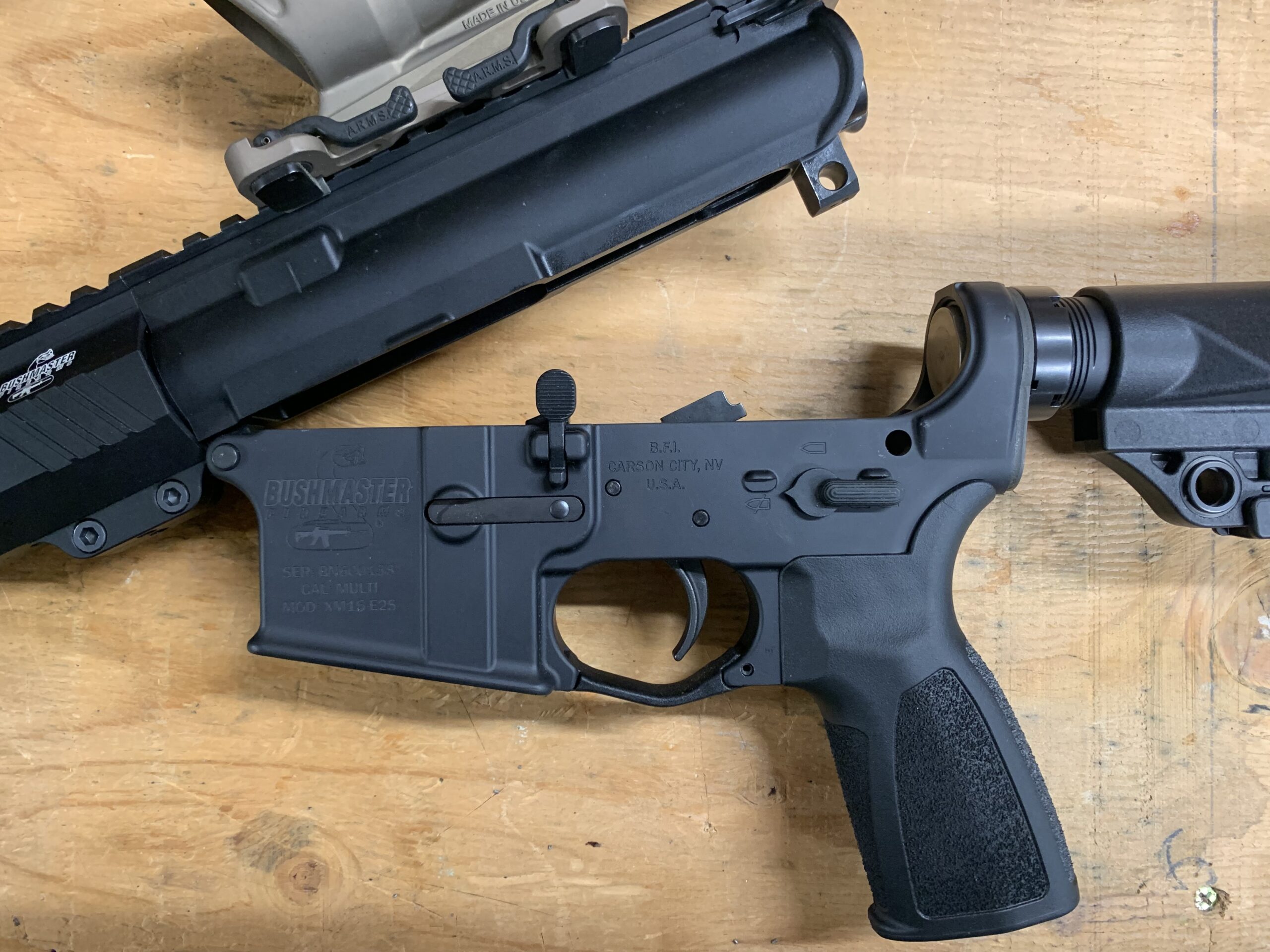
Bushmaster did well at offering a quality AR for a good price. Often, lower-priced AR rifles have safeties that are gritty and stiff, and simply awful triggers. Operation and handling of the Bravo Zulu is smooth and comfortable—as it should be. I like the pull of the two-stage trigger, which breaks cleanly just under 4 pounds.
Trigger Issues with the Bravo Zulu
During shooting, I did encounter an issue with the trigger that had me baffled, but I believe I figured it out. The rifle cycled and functioned flawlessly when fired from the shoulder or in improvised positions, but the trigger would not reset when firing from sandbags during accuracy testing. The spent case ejected, another round was stripped from the magazine and pushed fully into battery, but the hammer would not be captured by the disconnector. When single fed with an empty magazine, the bolt would lock back and the trigger would reset.
I thought it could be a cold/lubrication issue, but I was able to replicate it indoors while cycling the action, only if I held a gentle pressure on the trigger. If the trigger is held back firmly, the disconnector grabs the hammer every time. My theory is that the disconnector spring on this sample may be a little too stiff, and only soft pressure on the trigger allows enough play to not let the hammer hook push down past the disconnector hook.
I swapped this trigger for a mil-spec trigger and encountered no issues, and I’m currently waiting on another DM2S trigger to see if it’s a fluke (I’ll update this story when the time comes). I don’t like having issues like this, but if it were an AR I bought, I’d just drop a Geissele or Timney trigger in and have a top-notch trigger in 5 minutes. Because it’s such an easy fix, I don’t place as much weight on trigger issues of AR’s as I do with some other rifles.
Shooting the Bravo Zulu
The good news about the Bravo Zulu in .350 Legend is that it’s a good shooter. It’s 1.75-inch average across all groups and ammunition is better than I expected, and perfectly suitable for a realistic 200-yard range for .350 Legend rifles. The most accurate ammunition was Winchester’s Deer Season 150-grain Extreme Point, which averaged 1.34 inches.
This would make a good crossover rifle for deer, hogs, and even self-defense. Because it fires .355-inch diameter bullets, it’s compatible with many bullets intended for the 9mm Luger, like in Browning’s 124-grain FMJ loads. A handloader might discover some hard-hitting loads with bullets that won’t over-penetrate, or could achieve exceptional velocities with monolithic bullets from companies like Lehigh Defense. It’s something I plan on investigating further.
Traditions Outfitter G3
Key Features
- Cartridge: .350 Legend
- Capacity: 1 round
- Action: Break-action, single-shot
- Stock: Injection-molded polymer, black
- Weight: 6 pounds, 7 ounces (measured)
- Trigger: 2 pounds, 12 ounces (measured)
- Barrel: 22 inches, muzzle threaded ⅝-24, radial muzzle brake
- Overall Length: 36.5 inches
- Price: $459
- Optic Used: Maven RS.2 2-10×38
- Average Overall Group Size: 2.30 inches
- Average of Best 10 Groups: 1.93 inches
Pros
- Handy and quick-pointing
- Cerakote finish for weather-resistance
- Good trigger
- Includes hammer cocking bars
- Threaded muzzle
Cons
- Not exceptionally accurate
A single-shot is one of the best deer rifles for youngsters to start with, and it’s a great option for adults too. A sleeper in the centerfire cartridge rifle world is Traditions Firearms, which focuses much of their efforts on muzzleloaders. The Outfitter G3 in .350 Legend is a centerfire break-action single-shot rifle that’s similar to the Traditions Nitrofire muzzleloader that uses the Federal premium Firestick charges.
The G3 Outfitter has black polymer furniture and both the frame and barrel have a matte stainless-steel-looking Cerakote finish. The action opens via a large button in front of the trigger guard, and the gun uses a rebounding hammer that can’t touch the firing pin unless the trigger is held to the rear. It’s got a good two-stage trigger that breaks at less than three pounds, and my sample has just a small bit of creep before the break.
Shooting the Outfitter G3
The Outfitter G3 is available in a variety of calibers, and in .350 Legend comes with a radial muzzle brake that’s attached via ⅝-inch by 24 threads—which are standard for .30-caliber muzzle devices. The gun is suppressor-ready, but I did notice a dramatic impact shift when using a suppressor. This rifle wasn’t as accurate as some of the other rifles I’ve tested in .350 Legend, but for the cartridge’s capabilities, it’s totally adequate.
The Outfitter is easy to operate, and though the rifle doesn’t eject spent cases when opened, the extractor pulls the spent case from the chamber for easy removal. The hammer spur makes it a breeze to cock and de-cock with a scope, and the wide fore-end is great for resting on bags or a shooting rail.
CVA Cascade XT
Key Features
- Cartridge: .350 Legend
- Capacity: 4+1 rounds, 1 round with single-shot adapter
- Action: Bolt action, three-lug
- Stock: Injection-molded polymer
- Weight: 7 pounds, 2 ounces (measured)
- Trigger: 2 pounds, 7 ounces (measured)
- Barrel: 22 inches, muzzle threaded ⅝-24 (5/8-inch x 24) with radial muzzle brake
- Overall Length: 44.25 inches
- Price: $770
- Optic Used: Leupold VX5HD 3-15X44mm
- Average Overall Group Size: 1.33 inches
- Average of Best 10 Groups: .75 inches
Pros
- Hefty and stable
- Great trigger
- Great accuracy
- Suppressor ready
Cons
- Action doesn’t feed well with several .350 Legend loads
The CVA Cascade XT is a rifle that has done well in our gun test, and represents a good value for a mid-priced hunting rifle—rifles in the $600 to $1,200 range. It’s a workman’s rifle and prioritizes function over frills. We’ve tested other models, but the XT is built to be a heavier platform for precision at longer distances. It’s got a three-lug, 60-degree-throw bolt that’s similar to what you’ll see on rifles like the Ruger American, feeds from a detachable magazine, and has a molded polymer stock with a slightly tacky finish that doesn’t gather dust, but provides great traction in slippery conditions.
Chambered in .350 Legend, The Cascade XT is fed from either a 4-round double-stack magazine, or a single-shot adapter that’s like the old AR15 Bobsled magazines, with a trough for single feeding rounds where single-shot is required or preferred. The XT is a hefty rifle compared to many other .350 Legend rifles. Large-framed shooters, or those who are hunting with a good rifle support or rest will like this. The rifle is sized appropriately for long-range shooting with more powerful cartridges like the .308 or 6.5 PRC, and the mild little .350 Legend gives little recoil. Using a suppressor tames it even further. Kids and small-framed shooters will likely find this rifle to be a bit bulky.
Shooting the Cascade XT
The Cascade XT has a smooth action and functions well with other cartridges we’ve tested it in, but it had problems feeding most of the .350 Legend ammo I shot through it. The cartridge is short, straight-walled, and typically uses blunt projectiles, and the bullets would often jam against either the feed ramp or catch on the edge of the chamber. I like the double-stack magazine design, but the distance from the front of the magazine to the back of the chamber is about 50 percent of the cartridge’s overall length. Even when using the single-feed adapter, I had trouble with cartridges hanging up on the back edge of the chamber. Because there’s only spring tension holding the rear of the magazine in place, when trying to get cartridges to slide free of the magazine, the magazine doesn’t stay firmly in place.
Sharp-pointed bullets seemed to feed pretty well through the rifle, but the most accurate load I tested was Barnes Vor-Tx 170-grain TSX which averaged .807 inch 5-shot groups. Another good load was Winchester’s 180-grain Power Point, which averaged 1.24-inch 5-shot groups. This rifle would also likely pair well with Lehigh Defense 150-grain Controlled Chaos bullets and be an effective 200-yard rifle.
Key Features
- Cartridge: .350 Legend
- Capacity: 1 round
- Action: break-action, hammer-fired
- Stock: Walnut stock and fore-end
- Weight: 7 pounds, 3 ounces
- Trigger: 4 pounds, 1 ounce (measured)
- Barrel: 22 inches, brass bead front, adjustable flip-up rear sights
- Overall Length: 37.5 inches
- Price: $470
- Optic Used: Leupold VX Freedom CDS 4-12 x 40
- Average Overall Group Size: 2.33 inches
- Average Size of Top 10 Groups: 1.74 inches
Pros
- Simple and tight fitting
- Great looking Walnut furniture
- Good iron sights
- Toolless takedown
Cons
- Trigger reach is a little long
Many single-shot rifles have a reputation for being cheap guns for kids to use until they’re ready for something better, not this one. The Henry Single Shot Rifle is one that’s built and finished well. At first glance, it’s a rifle that you would want to stay in the family, not simply a club to jam under the seat of the pickup. It has a nice, blued finish and beautiful walnut stock and fore-end. My only gripe with that otherwise fine finish is that the engraving on the barrel can develop a slight rusty patina.
This single shot .350 Legend rifle has a brass bead front sight and flip-up adjustable rear sight—much like you’ll find on the Ruger 10/22. It has a release lever on the tang to open the action and a rebounding hammer that will only strike the firing pin if the trigger is being held down. It has a non-ejecting case extractor and a heavy barrel that’s .740 inches in diameter at the muzzle.
A Multi-Generational Rifle
This rifle isn’t designed to be a bargain-basement model. It’s a deer rifle that you could pass down to your kids. The wood-to-metal fit is good, and the stock has a nicely contoured rubber recoil pad. The action can be taken apart by knocking out the hinge pin and put back together just as easily. The fore-end is secured to the barrel by a fixture at the rear, and single barrel-pin screw just behind the forward sling swivel stud.
Although the Single Shot would be in its element in the deep woods with only iron sights, I scoped the rifle for accuracy testing. As with most rifles that are designed to be used with iron sights, the comb of the stock was low, and it’s not especially easy to maintain consistent head position when using a scope. I would order a hammer extension from Henry if I were going to use a scope on the rifle. I found it challenging to shoot groups with the single shot simply because you must break position after each shot to reload.
Shooting the Henry Single Shot
The trigger on the Henry isn’t bad, but for me, the reach to the trigger from the grip was a little long. The non-ejecting extractor won’t send spent cases flying, and you must pull each case out by hand before loading a fresh cartridge. It was fun and comfortable to shoot, and the heavy build of the rifle certainly helps reduce felt recoil.
The Henry shot accurately enough to be adequate for the relatively short effective range of the .350 Legend, but its five-shot group sizes weren’t fantastic. However, for someone who’s considering a single shot .350 Legend rifle, I would take the results with a grain of salt. I saw a specific correlation between the barrel warming up and accuracy eroding. In fact, in 4 of 20 groups, the first three shots measured less than an inch. It was common to see groups expand dramatically on shots number four and five. For a single shot, you’re probably never going to get to shots four and five in a hunting situation.
Key Features
- Cartridge: .350 Legend
- Capacity: 4+1
- Action: push-feed, two-lug, bolt action
- Stock: Black synthetic
- Weight: 6 pounds, 8 ounces
- Trigger: 2 pounds, 7 ounces (measured)
- Barrel: 22 inches, fluted
- Overall Length: 42.75 inches
- Price: $454
- Optic Used: Maven CRS.1 3-12 x 40
- Average Overall Group Size: 1.93 inches
- Average Size of Top 10 Groups: 1.39 inches
Pros
- Good Trigger
- Smooth Bolt Operation
- Comfortable Monte-Carlo Cheek Rest
- Accurate
Cons
- Action and magazine are over-sized
- Bolt fit is sloppy in raceways
Mossberg’s Patriot series of rifles brings a great value to the table for hunters, and their Patriot Predator in .308 topped the field of a budget rifles test I conducted earlier this year. The Patriot Synthetic chambered in .350 Legend is also a good value for a potential deer rifle.
The Patriot synthetic is much like other Patriot rifles, in that it has a rigid and comfortable synthetic stock, a good finish on the barrel and receiver, and a shallow-fluted bolt body. Unlike all the other .350 Legend rifles in the test, this one has a thinner profile, fluted barrel that measures .623 inches in diameter at the muzzle. The muzzle is finished with a protective, recessed target crown.
It’s fed with a detachable 4-round box magazine and has a user-adjustable trigger that breaks at just about 2.5 pounds on my sample.
A trade-off for the cost savings of this rifle is that it’s essentially a .308-sized action that’s adapted to shoot the shorter .350 Legend cartridge. Although larger than magazines of models like the XPR, this one still only holds four rounds. Also, the bolt can be drawn back well beyond the back of the next cartridge in the magazine. It has no negative effects on the functioning of the rifle, but does add a bit of unnecessary play and movement into the system.
Shooting the Mossberg Patriot
Like other Mossberg Patriots, this one shoots and cycles smoothly, and I encountered no issues. I found the bolt to have quite a bit of play in the raceways, and it feels loose when pulled all the way back. The light-breaking trigger and comfortable stock made shooting the Mossberg a pleasure, and it would make a fine deer rifle.
This .350 Legend rifle was also very accurate with several different factory hunting loads. The best-shooting factory loads were Winchester’s 150-grain Copper Impact, Winchester 160-grain Defender, and Winchester Deer Season XP 150-grain Extreme Point. For the loads it liked, this .350 Legend rifle averaged just under 1.5 inches for 5-shot groups. It didn’t print any sub-MOA groups, but what it did shoot, it shot consistently.
Key Features
- Cartridge: .350 Legend
- Capacity: 4+1
- Action: push-feed, two-lug, bolt action
- Stock: Black synthetic
- Weight: 5 pounds, 13 ounces
- Trigger: 3 pounds, 10 ounces (measured)
- Barrel: 18 inches
- Overall Length: 38.5 inches
- Price: $403
- Optic Used: Maven RS.2 2-10 x 38
- Average Overall Group Size: 1.45 inches
- Average Size of Top 10 Groups: 1.13 inches
Pros
- Very accurate
- Great Price
- Adjustable “Accustock”
- Adjustable “Accutrigger”
Cons
- Action is over-sized
- Bolt operation is very stiff
Savage is one of the leaders in producing affordable rifles that are still accurate, and that’s certainly the case with the Axis II in .350 Legend. It’s a simple rifle with a two-lug, push-feed action, nested into a black synthetic stock. Savage has upped their game on stocks in recent years, and the stock on the Axis II is comfortable, has a stiff fore-end, and is adjustable for length of pull.
This .350 Legend rifle has an 18-inch, heavy-profile barrel with a slightly recessed crown. It’s fed with a 4-round detachable magazine and has Savage’s proprietary adjustable Accutrigger system. The Accutrigger has a center bar that makes it feel somewhat like a two-stage trigger. The large tang safety is easy to manipulate and doesn’t lock the bolt when engaged.
The action is over-sized, and long enough to be used for cartridges like the .30/06. In fact, the ejection port extends about an inch behind the back of the .350 Legend magazine. This is a cost-saving measure that doesn’t really affect how the rifle shoots, but for such a short cartridge, it adds a level of extra movement that you may or may not mind.
Shooting the Savage Axis
The Axis II lived up to its reputation of accuracy, and the average of its top 10 groups was exceptional for a budget deer rifle (and what I expected to get out of the .350 Legend). Like several other rifles in this test, this rifle’s favorite ammo was the Winchester Deer Season XP 150-grain loads (1.18 inches), followed by the Winchester 150-grain Copper Impact loads (1.35 inches).
Read Next: The Biggest Myths and Misconceptions Around Deer Rifles, Cartridges, and Shooting
Accuracy was competitive between several of these rifles, and the Axis II is aided by its comfortable stock and trigger. However, I wish it would be a bit better in cycling. The bolt takes a relatively large amount of force to lift—so much that it’s tough to open the bolt one-handed while on the bench without bracing the rifle. Once the bolt is cocked, it’s easy to cycle, but it does have excess movement to the rear because of the length of the action. If you just care about how it shoots, then don’t concern yourself, but the stiffness of the action would likely be difficult for kids to master. Aside from that, it’s a great budget deer rifle.
Things to Consider Before Buying a .350 Legend Rifle
Purpose
Admittedly, the .350 Legend is a limited-purpose cartridge. There are lots of rifle cartridges that are superior in measurable ways. If you don’t hunt in a “straight-wall state” or need a soft-kicking, close-range deer rifle, there are probably better options for you. However, in addition to being a great deer cartridge, the .350 Legend would likely be good for hogs, and even used for defensive purposes in an AR platform if you’re already getting one for deer.
Action Size
The .350 Legend is a true short-action cartridge that can fit in a standard AR magazine. That makes it perfect for the AR platform and compact bolt actions. To save cost and offer a more affordable end-product, some .350 Legend rifles have actions long enough to accommodate .308 or even .30/06-length cartridges. These longer actions and their magazines are simply adapted to utilize the shorter .350 Legend cartridge. There isn’t a meaningful weight difference and the longer actions didn’t present any function issues to me, but some hunters will feel that the over-sized actions diminish the convenience of such a compact cartridge.
Budget and Quality
As with any rifle, your budget will have a huge impact on the rifles that you’re shopping for. Many of the .350 Legend rifles in this test are very budget-friendly and would make great deer rifles. Try to handle the rifles and pay attention to handling characteristics, not just the accuracy you expect from them. If you want a rifle that’s smooth handling, you might need to pay a little more for it.
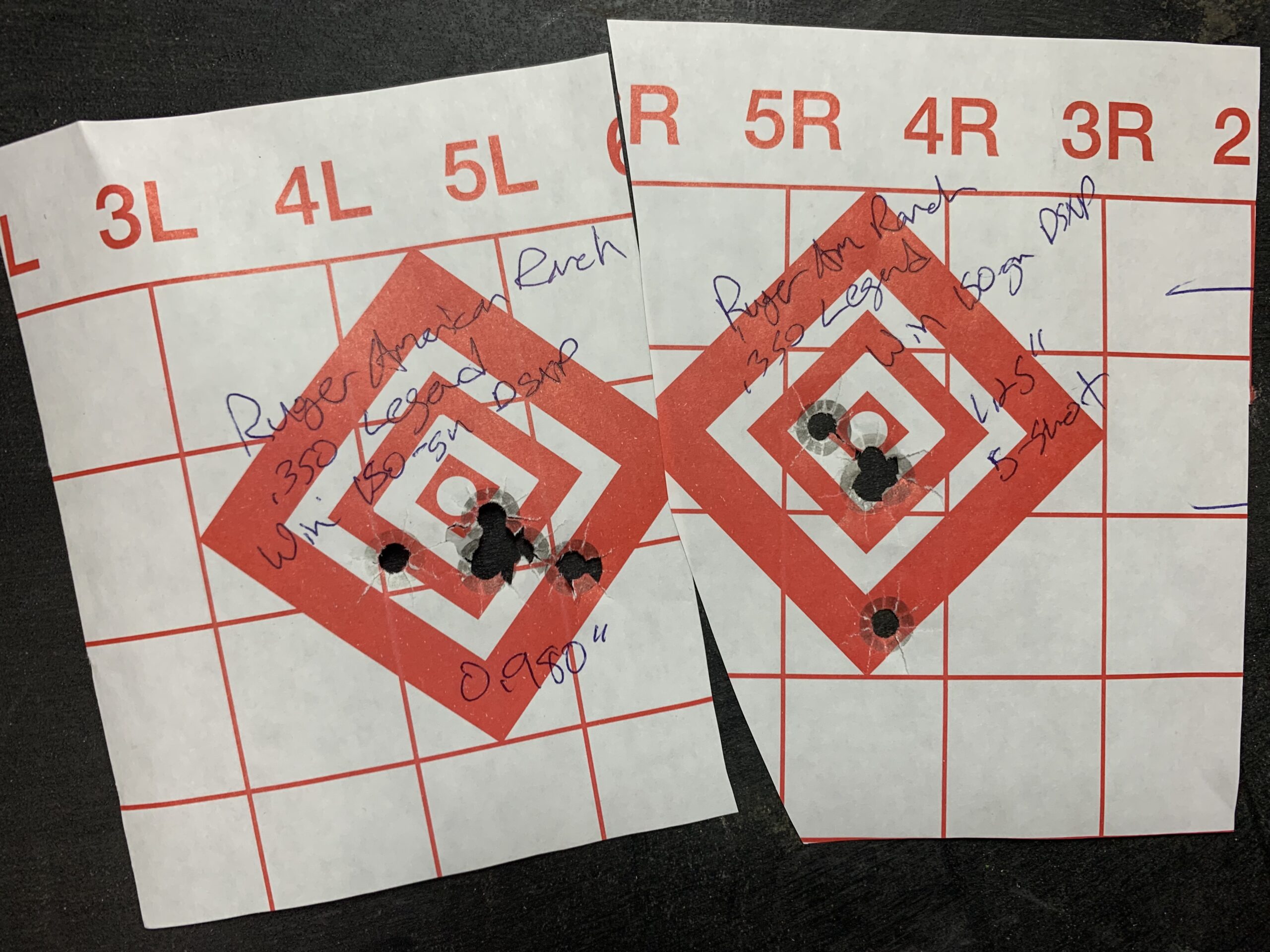
FAQ’s
Q:
What’s the best barrel length for .350 legend?
Although we haven’t done extensive testing on barrel length, it seems that most rifles offered have 16- to 18-inch barrels, and they perform well. The .350 Legend uses a small amount of relatively fast-burning powder, so it’s not likely that longer barrels would give you a large increase in velocity.
Q:
What’s the best scope for a .350 legend?
Because the .350 Legend is primarily effective at or under 200 yards, The best scope will likely top out in the 9x or 10x magnification range. Look for a scope that has a 1x, 2x, or 3x magnification on the low end for hunting in thick woods. Something like the Leupold VX Freedom 2-7 x 33 or the Vortex Diamondback 1.75-5 x 32 would be ideal for this cartridge.
What is the range of the 350 Legend for deer?
Because the .350 Legend fires relatively blunt bullets at medium velocities, it loses steam quickly. Most .350 Legend ammo will be effective to about 150 yards, but some ammunition can be accurate and effective out to 200 yards.
What is the 350 Legend good for?
The .350 Legend is good for medium-sized big game at ranges under 150 yards. It works great on deer and black bears, and in an AR platform, is an effective self-defense cartridge.
Final Thoughts on .350 Legend Rifles
Because I live in Alaska—about as far from straight-wall deer rifle states as you can get—I’d never sought out the .350 Legend. However, after testing these rifles, I’ve been thoroughly impressed by their overall accuracy. The average group size of all groups from the .350 Legend rifles tested was 1.78 inches. That includes all the bad groups too. Compare that to the average size of all groups for 11 different .308 rifles I tested this year (including some premium rifles), which was 2.02 inches.
I think that if you do live in a straight-wall deer state, the .350 Legend is an excellent candidate to consider for a deer rifle. Their accuracy, suppressor-friendliness, and range of potential handloading options make the chambering more versatile than you might think.

